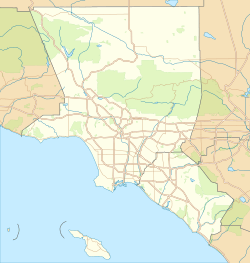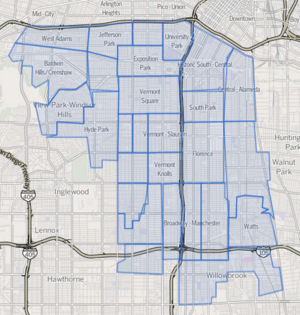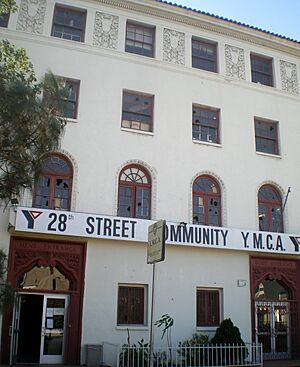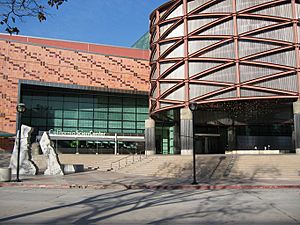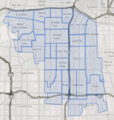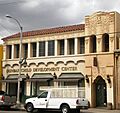South Los Angeles facts for kids
Quick facts for kids
South Los Angeles
|
|
|---|---|
|
Region of Los Angeles County
|
|
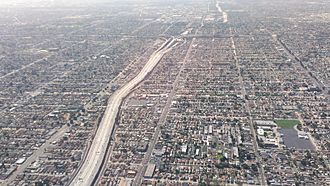
|
|
| Country | United States |
| State | California |
| County | Los Angeles |
| Cities | Los Angeles Compton Inglewood |
| Unincorporated areas | View Park–Windsor Hills West Athens Westmont Florence-Graham Willowbrook |
South Los Angeles is a large area in Los Angeles County, California. It's mostly within the city of Los Angeles, located south of downtown. People also used to call it South Central Los Angeles or just South Central.
City maps show it as a rectangle about 16 square miles big. In 2003, the Los Angeles City Council officially changed its name to "South Los Angeles." This name can also mean a bigger area, about 51 square miles, which includes parts of Los Angeles city and five other nearby communities.
Contents
Exploring the Geography of South Los Angeles
How Los Angeles Defines the Area
The City of Los Angeles calls a specific part "South Los Angeles Community Plan Area." This area is about 15.5 square miles. It's next to communities like West Adams, Baldwin Hills, and Leimert Park on the west. To the east is Southeast Los Angeles.
The Los Angeles Times Map Project
The Los Angeles Times Mapping Project shows the South Los Angeles region as much larger. It covers about 51 square miles. This includes 25 neighborhoods inside the City of Los Angeles. It also includes three neighborhoods in the County of Los Angeles that are not part of any city.
Google Maps View
Google Maps shows a similar area to the Los Angeles Times map. But there are some small differences on the western side. For example, it leaves out a part of Los Angeles west of La Brea Avenue. It also includes a part of the City of Inglewood north of Century Boulevard.
Neighborhoods and Districts
The Los Angeles Times survey lists many neighborhoods in the South Los Angeles region.
Neighborhoods in Los Angeles City
- Adams-Normandie
- Baldwin Hills/Crenshaw
- Broadway-Manchester
- Central-Alameda
- Chesterfield Square
- Exposition Park
- Florence
- Gramercy Park
- Green Meadows
- Harvard Park
- Historic South Central
- Hyde Park
- Jefferson Park
- Leimert Park
- Manchester Square
- Nevin
- South Park
- University Park
- Vermont Knolls
- Vermont Square
- Vermont Vista
- Vermont-Slauson
- Watts
- West Adams
Neighborhoods in Los Angeles County
These areas are not part of any city but are in the county.
A Look at South Los Angeles History
Early 1900s to 1940s
South Los Angeles has a long history, starting in the early 1900s. In the 1920s, West Adams was a very popular area. Wealthy people built large mansions there. Working-class families settled in Crenshaw and Hyde Park. Over time, more affluent Black families moved into West Adams and Jefferson Park.
As Los Angeles grew, new buildings appeared along Wilshire Boulevard. This shifted the city's development away from South Los Angeles.
In the eastern part of South Los Angeles, land was mostly undeveloped in the late 1800s. Chinese and Japanese American farmers grew produce there. In 1903, a racetrack called Ascot Park was built. Later, in the 1910s, the park was removed. This made way for many new homes and factories in the 1920s.
By 1940, most of Los Angeles's Black population lived along Central Avenue. This area became the heart of the Black community. It was also one of the first places in the western U.S. to have a jazz music scene. During this time, many Black families moved to Los Angeles for jobs. They faced housing shortages. The city built the Pueblo Del Rio project to help.
From 1948 to the 1960s
During the 1950s, new freeways were built. These roads often followed old lines that separated different communities.
From the 1970s to the Mid-2000s
Starting in the 1970s, many factories in the area closed. This meant many people lost their jobs. This led to more unemployment and poverty.
In 2003, the Los Angeles City Council voted to change the name from "South Central Los Angeles" to "South Los Angeles." Supporters hoped this would help remove a negative image linked to the old name.
The 2010s and Beyond
By the early 2010s, the crime rate in South Los Angeles had dropped a lot. New building projects, better police patrols, and community programs helped. These efforts brought murder and crime rates down to levels not seen since the 1940s.
After the 2008 economic recession, home prices in South Los Angeles went up. By 2018, many saw the area as a good place for new development. Some residents worry that new projects will make rents too high. The building of the K Line light rail has also encouraged more building near the new stations. The NFL Stadium in Inglewood is also seen as a reason for new development.
The news that Los Angeles will host the 2028 Olympics also boosted real estate values. Many Olympic events will happen near the USC campus.
Early 2020s to Today
Crime in South Los Angeles increased during the COVID-19 pandemic. This caused a rise in crime rates, similar to levels seen in the late 1990s and early 2000s.
Understanding the People of South Los Angeles
Changing Populations
By the late 1980s, more and more Hispanic and Latino people moved into South Los Angeles. They mostly settled in the northeastern part of the region.
Experts say that between 1970 and 1990, the area changed a lot. It went from being 80% African American and 9% Latino to 50.3% African American and 44% Latino. Many African Americans from South Los Angeles have moved to other cities like Palmdale and Lancaster. South Los Angeles has also welcomed immigrants from Mexico and Central America.
Recent Population Data
According to a 2014 report, South Los Angeles had 271,040 residents. The population was made up of:
- Asian - 4.9%
- White - 21.4%
- African-American - 28.7%
- Other Race - 39.4%
When looking at ethnicity:
- Not Hispanic or Latino - 39%
- Hispanic or Latino - 61%
The 2000 United States census showed that Mexican and African ancestries were most common. Mexico and El Salvador were the most common birthplaces for people born outside the U.S.
Education in South Los Angeles
South Los Angeles is home to the University of Southern California (USC). USC is a private research university in the University Park neighborhood. It is California's oldest private research university.
Los Angeles Unified School District Schools
Many schools from the LAUSD are located in South Los Angeles.
LAUSD Elementary Schools
|
LAUSD Middle Schools
|
LAUSD High Schools
|
LAUSD 6-12 schools:
|
Colleges and Universities
|
Community Colleges
|
Universities
|
Famous Landmarks in South Los Angeles
South Los Angeles has many important and interesting places.
- BMO Stadium - A modern soccer stadium.
- California African American Museum - A museum about African American history and culture.
- California Science Center - A fun place to learn about science, home to the Space Shuttle Endeavour.
- Central Avenue - A historic street known for its jazz music scene.
- Clark Library - A special research library.
- Coca-Cola Building - An interesting historic building.
- Dunbar Hotel - A famous hotel that was important for the Black community.
- Exposition Park - A large park with museums and sports venues.
- Fire Station No. 30 - A historic fire station.
- Leimert Park - A cultural hub, especially for the African American community.
- Lincoln Theater - A historic theater.
- Los Angeles Memorial Coliseum - A famous stadium that hosted the Olympics twice.
- Los Angeles Sports Arena (demolished) - A former sports and concert venue.
- Lucas Museum of Narrative Art (under construction) - A new museum being built.
- King/Drew Medical Center - A major hospital.
- Second Baptist Church - A historic church.
- 28th Street YMCA - A historic community center.
- University of Southern California - A large university.
- Watts Towers - Unique and tall art structures made from found objects.
Notable People from South Los Angeles
Many famous people in music, sports, and politics have come from South Los Angeles.
Music and Entertainment Stars
- Ab-Soul
- Ahmad Jones
- Barry White
- Blxst
- Charles Mingus
- Coolio
- Dr. Dre
- Eazy E
- Etta James
- Ice Cube
- Issa Rae
- Jhené Aiko
- John Cage
- Kendrick Lamar
- Meghan Markle
- Montell Jordan
- Nipsey Hussle
- Schoolboy Q
- Skee-Lo
- Tiffany Haddish
- Tone Lōc
- Ty Dolla $ign
- Tyrese Gibson
Sports and Athlete Heroes
Influential Politicians
- Karen Bass - Current Mayor of Los Angeles.
- Tom Bradley - Former Mayor of Los Angeles.
- Yvonne Brathwaite Burke - Served in the State Assembly and U.S. House of Representatives.
- Mervyn M. Dymally - Served as Lieutenant Governor of California.
- Augustus Hawkins - A long-serving member of the U.S. House of Representatives.
- Maxine Waters - A current member of the U.S. House of Representatives.
Artists, Filmmakers, and Writers
- Ava DuVernay - A well-known filmmaker.
- Charles Burnett - A respected film director.
- John Singleton - A famous film director and writer.
- Kehinde Wiley - A celebrated painter.
Images for kids
See also
 In Spanish: Sur de Los Ángeles para niños
In Spanish: Sur de Los Ángeles para niños


